#quantum information
Text
Quantum information, entropy and emergence, and the dispersed arrow of time in the quantum realm

So, I did some new art right now. I used a white Faber-Castell artist pen brush on a black DIN A5 piece of paper (220 g/m^2).
Maybe one day I might be able to explain the concepts and ideas I depicted.
#quantum information#fuzzy logic#quantum logic#quantum mechanics#art#surrealism#science art#math art#math#mathematics#physics#physics art#surreal#quantum physics#stem#stem and art#topological qubits#qubits#möbius strip#non-orientabie surface#arrow of time#entropy#emergence#time#diffraction#interference#entangled#quantum entanglement#momentum
127 notes
·
View notes
Text
Quantum Circuit Cutting - with Randomly Applied Channels

Recently, I briefly introduced what circuit cutting is, why it is an advisable thing to do with current quantum hardware (NISQ devices) and what additional costs the cutting is causing. However, I did not go into detail how such a circuit cutting method can look like in detail - this is what this entry will be about. In particular, we will have a look on the circuit cutting procedure proposed by Lowe et. al. [1] in which randomly applied channels are able to cut a circuit.
Identity on Cut Circuits
As mentioned in the previous entry, circuit cutting requires to find a proper identity channel on the cut wires which has reasonably low sampling overhead - the definition of the identity is thus the heart of every circuit cutting procedure. In general, such an identity has the form

where Φ_i is some properly chosen quantum channel. The corresponding cost depends on the value κ

which is the L1 norm of the real coefficients of the identity channel above:

Thus, we see that the main possibility to reduce the sampling overhead is to reduce this value. One possibility with small sampling overhead is the following (however, it is not minimal! The method described in [2] has a lower overhead, but we will not go into detail of this).
The identity channel used in [1] looks like

Here, d=2^k is the dimension of the subspace governing the qubits of the cut. The variable z denotes a Bernoulli random value where z=1 appears with probability d/(2d+1). Later, we will derive this form of the identity channel and will see how this probability and also the expectation E_z emerges. Since, there are two values of z, there are also two quantum channels which can be applied. The first one, Ψ_0, is a measure-and-prepare channel:

The unitaries which are applied on the state prior to measurement have to comprise a 2-design (at least) because otherwise the derivation would not work. Such a design is formed by e.g. Clifford gates but there are many possibilities, one could also rely on approximate designs. Since the form of a quantum channel is not so pictorially, you can see in the following how this channel looks like in "circuit-language":
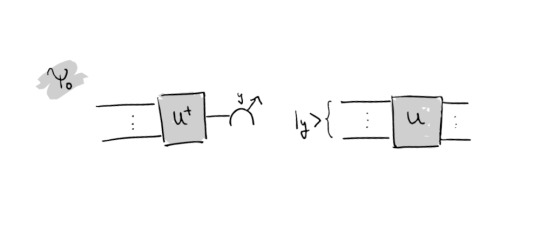
This means, one applies U^\dagger on the k cut wires, measures in z-basis and retrieves a bitstring y. A state in computational basis corresponding to this bitstring gets initialized and then U is applied. All of this is repeated many times.
Note that applying such a circuit in the middle of a larger circuit destroys entanglement of the global state and this is also the reason why cutting requires a lot of sampling (quantified by the sampling overhead): The effects of entanglement in the final result must be regained somehow by repeating the procedure numerous times.
The other channel, Ψ_1, is a simpler one. It is the so-called fully depolarizing channel in which all of the information within the cut (within a sample) is lost:

In practice, the action on the cut part of the circuit is as follows: First one measures the k cut wires in the computational basis. Afterwards one takes a uniformly sampled bitstring x and initializes it on the wires - as in the following circuit snippet:
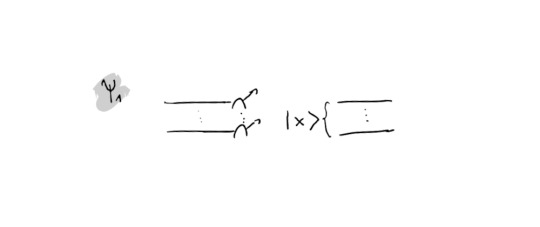
Guiding through the Derivation
Now, as we have settled the definitions, let's go through the derivation of this identity channel! At first, we need an equation which we shall not prove as this would be more involved (based on Haar measure etc.). It is called Werner Twirling Channel:

This equation is particularly nice because the right hand side is much much simpler than the left hand side, which requires all of the unitaries in the design. At the same time, the right hand side could be quickly written out by hand for e.g. d=1. This will come in handy in deriving the identity channel.
The idea of the proof is to start with one channel Ψ_0 and massage it a little to find an expression of Ψ_1 within it and then massaging it a little further and finding an expression for the identity channel.
Hence, start with the channel Ψ_0:

A lot is going on here, thus let's go through the equalities step by step: From the first to the second line the only thing happening is that we insert an identity (using completeness of the computational basis). Going to the next line, the two scalar factors are swapped and the states with index i can be used to rewrite the expression into a Tr. By exploiting the properties of tensor products and the trace, one can draw outside the sum a partial trace expression in the last line. This shape is nice, because we can recognize the left hand side of the above equation and can simplify the underbraced expression:
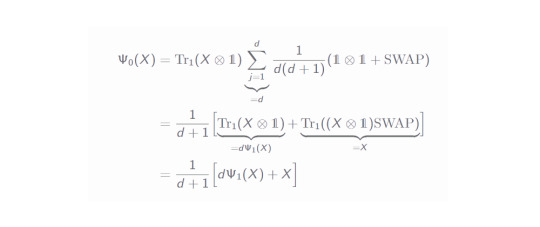
Since the expression within the sum does not depend on the index j anymore, this sum merely gives a factor d. In the second line we draw the partial trace factor into the brackets and recognize the Ψ_1 channel! Additionally, the part with the SWAP operator can be simplified as well (you can easily prove this by checking it with a 4x4 SWAP matrix and using a general matrix X). All of this helped us immensely in relating both channels to each other. Reshaping this equation a little gives us:

In the second line, we draw a factor outside in order to retrieve the Bernoulli probabilities we have defined previously and then, by respecting the additional sign, this can be easily rewritten as an expectation value in the last line.
What about the cost?
Now as we have both defined and derived the identity circuit expression, let's relate it to the introducing sentences about the sampling overhead. The value of κ can be easily computed:
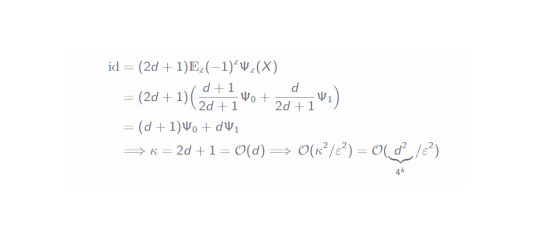
As we can see, the sampling overhead is exponential in the number of cut qubits - this is a deficit in practice. Even though, there are slightly better circuit cutting procedures, the overhead always scales exponentially in the number of cut qubits. Although unfortunate, this makes perfect sense intuitively: The cutting destroys part of the quantum properties of the system and these must be reproduced classically (by sampling). Mostly everything quantum which is simulated classically scales exponentially (since the Hilbert space dimension grows exponentially with growing number of particles).
Overall, circuit cutting is an interesting new field in quantum computing which might help to go beyond the capabilities of current NISQ devices - nevertheless, there is always a price to pay and it will become evident in future research whether circuit cutting will be a common method or not.
---
References:
[1] Angus Lowe, Matija Medvidović, Anthony Hayes, Lee J. O'Riordan, Thomas R. Bromley, Juan Miguel Arrazola, Nathan Killoran. Fast quantum circuit cutting with randomized measurements. 2022. arXiv:2207.14734
[2] Hiroyuki Harada, Kaito Wada, Naoki Yamamoto. Optimal parallel wire cutting without ancilla qubits. arXiv:2303.07340
#physics#mysteriousquantumphysics#studblr#physicsblr#quantum computing#quantum#quantum physics#quantum information#women in science#stem#stemblr
32 notes
·
View notes
Text
Our reality is full of dots that are connected by strings which construct patterns which combine to create the web of existence. What you interact with, what you can see and fathom is your world, but we are inexorably connected to one-another. Whether we pay attention or not we share the web of the Earth, and affect each other even when the consequences are not within our worlds; in other words, it is understood but not fathomed. The expansion of multiple worlds create a movement that will collides at multiple points. When this shakes an entire web, our expanding comprehensions combine to reach the same page--a revelation occurs–what was not understood comes into clarity revealing an understanding that was previously out of reach. A revelation is a catalyst; it is the name of the climax of the comprehension that changes the direction we move in to a refined competence.
A revelation is a realization that changes everything.
11 notes
·
View notes
Text




Danko Georgiev’s axioms of quantum informational consciousness, from Quantum Information and Consciousness: a Gentle Introduction
5 notes
·
View notes
Text
Alain Aspect, John F. Clauser and Anton Zeilinger were just awarded the 2022 Nobel Prize in Physics for their works in quantum information science.
#nobel prize#nobel laureate#2022#science#personal#nobel prize in physics#alain aspect#john f. clauser#anton zeilinger#france#usa#austria#quantum information
7 notes
·
View notes
Link
So, in case you didn’t hear, Nobel prize scientists proved that quantum entanglement isn’t just some “spooky action at a distance” and is in fact, a real influence on particles at a quantum level. Now, I would advise you do your own research on the newest findings, as far smarter people than I can explain it better. But basically we now realize that two particles that were once linked, and are no longer linked, still can influence each other’s behavior even at a great distance. So, let’s think about this in terms of lucid dreaming. When I lucid dream, I can do whatever I want to whatever I want, regardless of the distance between me and the object I want to influence, because I can imagine myself being close to that object to influence it, thereby picking up an apple with my mind because I visualize how that apple would be lifted if I did it physically. And I must ask, isn’t this technique or method similar to what these sub-atomic particles are doing with quantum entanglement? Of course, not consciously. Two particles that are now a great distance apart can still influence the other’s behavior just because there were, at one point, linked. But ALL matter was at one point linked to the same location just before the BIG BANG. So, now I MUST ask, can any matter influence any other matter on a macro scale because their sub-atomic particles were once linked? And how far can we extrapolate this theory? Can an individual change or influence a “solid” object because the particles that make up that object were once ONE with the individual’s particles? Are we THIS CLOSE to creating lucid dreaming phenomena in waking life?
2 notes
·
View notes
Text
If you break it down as small as you could
The make up of you and me--it's energy
It's nothing but everything, everything
It's moving constantly
Floats to what you need
You send waves through the air
Thought by thought, prayer by prayer
Just because you don't know where
Doesn't mean it's not there
It is there, it's all you
Ear-to-ear
It's a frequency; you can tune it your way
The vibration, collection of your dreams
She is a queen, she's listening;
What you're sendin' is what you're gonna receive
What are the messages your move to make?
What is that travellin' from your heart to brain?
How many times can you think it in a day?
It starts between the eyes
Before it comes to life
You send waves through the air
Thought by thought, prayer by prayer
Just because you don't know where
Doesn't mean it's not there
It is there, it's all you
Ear-to-ear
Ear to Ear by ANIMA!, 2019
0 notes
Link
#quantum computing#quantum computing simulation#quantum algorithms#outreach#technology#innovation#quantum mechanics#quantum information#computationalmodeling#virtualexperiment#emerging technology#quantumrevolution#quantumtech
0 notes
Text
Use of Superposition and Entanglement in Quantum Algorithms
Superposition and entanglement are two of the key properties of quantum systems that allow for quantum algorithms to perform tasks more efficiently than classical algorithms.
Superposition: In classical computing, a bit can be in one of two states, 0 or 1. However, in quantum computing, a qubit can exist in a state of 0, 1, or a combination of both, known as superposition. This means that a qubit can represent multiple possibilities simultaneously. This allows for the possibility of parallel processing, where multiple calculations can be performed at once. In quantum machine learning, superposition can be used to perform multiple calculations on different data points or parameters at the same time, increasing the speed of the algorithm.
Entanglement: This is a property of quantum systems where two or more qubits become correlated in such a way that the state of one qubit can be affected by the state of another, even if they are physically separated. In quantum machine learning, entanglement can be used to represent the correlations between different features in a dataset. This allows for the possibility of performing multiple calculations on different features at once, reducing the time needed to find the solution.
In summary, Superposition and entanglement are properties of quantum systems that allow for quantum algorithms to perform tasks more efficiently than classical algorithms. Superposition allows to perform multiple calculations on different data points or parameters at the same time. Entanglement allows to represent the correlations between different features in a dataset and perform multiple calculations on different features at once.
0 notes
Quote
Quantum information transferred by quantum teleportation is not a physical quantity, but energy is a distinct physical quantity. Transferring physical quantities to remote locations is an unexplored area of technology.
Kazuki Ikeda
0 notes
Text
this is written form technology. This is alchemy in his pure form. These are spells. This is the magic of the future.
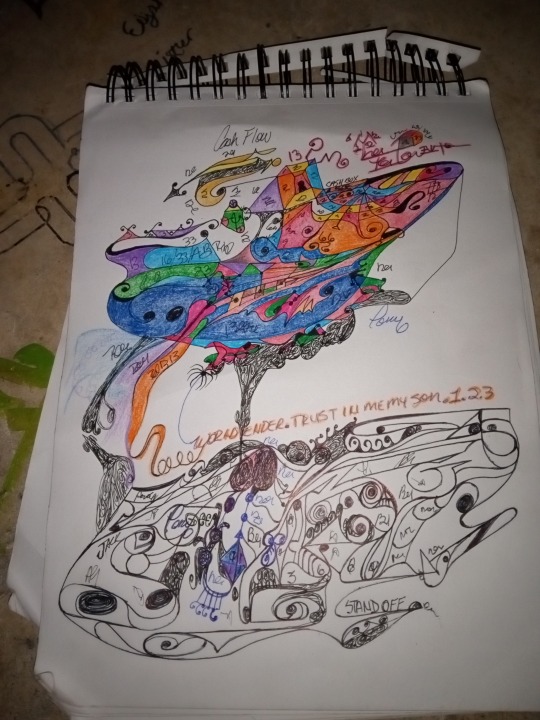
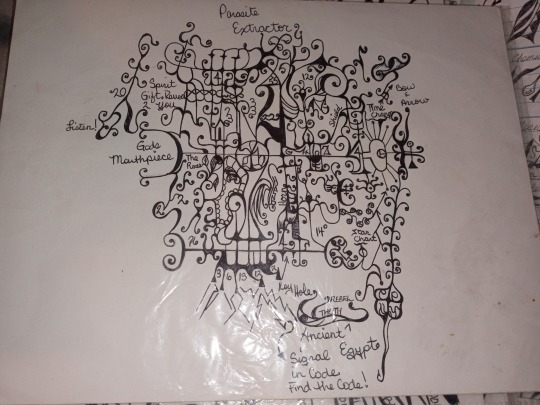
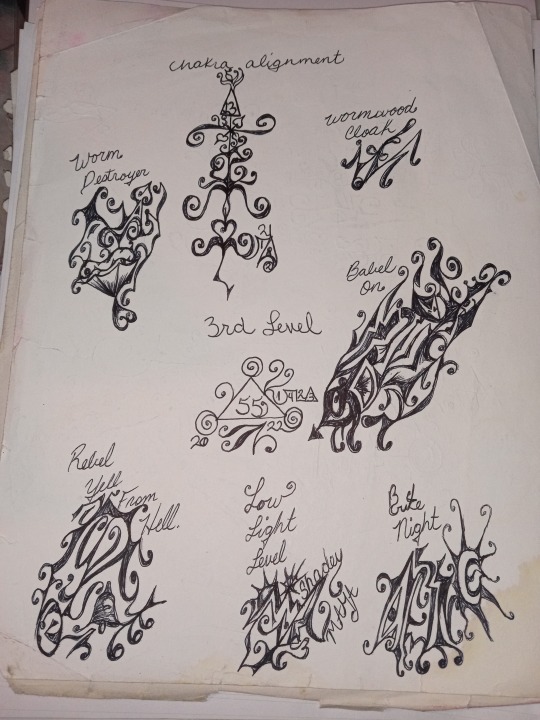
1 note
·
View note
Text
Thought experiment regarding non-linear causal nets using an analogy of "dynamical chess"
Imagine a flexible chess board where each move of the chess figures alters the board. And each alteration of the board has effects on the figures as well, causing alteration in the behavior of the figures [a.k.a. the rules each figure has as a pre-defined rule]. | (That's entanglement of feedback-loops.) - This leads to chaotic behavior, making predictions even more difficult and "turbulent".
[This sort of chess is like the interaction between spacetime and matter.]
Following a helpful quote by John Wheeler:
"Spacetime tells matter how to move; matter tells spacetime how to curve."
- John Archibald Wheeler, Geons, Black Holes and Quantum Foam: A Life in Physics
---
Why do I use the neologism "non-linear causal nets"?
There is a kind of idiom-like brabble, called "causal chains". It states a linear string of cause-and-effect. This is often far too simplified for explaining real-life phenomena, because often there are far more causes to an effect than just one. There happen many "causal chains" simultaneously, so to speak. These causal chains are entangled. Multiple of such linear cause-and-effects are entangled, until they are no longer a linear-string or multiple linear strings, but a complex web. Each causal chain alters each other. That is basically a fundamental principle often recognized in quantum mechanics - interference.
It describes conservation of momentum in an analogy-based and merely imagination-based language of knots and loops, similar to some approaches of string theory and (loop) quantum gravity.
Information weaving
"Information weaving" might be the silly name I would use for that collection of conceptions and re-interpretations.
"Information transforms" in this conception are weaving patterns. In concrete, these are interaction patterns like
- replication of interaction pattern (like law of inertia)
- and interference/alteration of interaction pattern (momentum).
These two transforms are the two primary transforms. You can combine them and create all possible sorts of patterns.
Furthermore,... these relate to addition and multiplication of imaginary numbers, resulting in either a translation or a rotation in the complex plane... These might relate to the information transforms stated above.
But the research regarding this is really difficult and curently my mind is too sluggish and too over-crowded to compute it well enough.
It might take some years until it's less mad nonsense.
...
Spacetime as emergent property of entanglement
I enjoy the project It from Qubit and Polymath Vijay's interpretation that spacetime is emergent due to entanglement.
In my interpretation/analogy of "information weaving" time is a string, and space is the web consisting of that string. Space and time are hence "two aspects of one and the same thing".
This is especially interesting if you consider the difference between a time and a space dimension.
A space dimension has two ways of propagation, so to speak: left-right, top-down, before-behind... (to put it in plain words)
When it comes to the time dimension, I consider it to have only one propagation direction: The future, like in the conception of the arrow of time.
But here it becomes complex. Since time is "mono-directional", say, it has only one direction to propagate towards, it might interact with itself - via feedback-loops. This results in literal entanglement if you consider the arrow of time to be a simple string. Loop, knot and weave that string/arrow with itself and you might have spacetime as a complex result, so to speak.
In regards to quantum entanglement and superposition this interpretation might make sense as well, but I am not far enough with my research about that topic to summarize it coherently.
Furthermore, you can also define quantum gravity as the "degree of clotting": or, say: Let's interpret gravity as a principle of clustering: Areas with more density gain density, and areas with less density lose even more density, to reduce gravity to its primary principle.
Gravity is hence a re-distribution, a re-ordering of matter, or information, so to speak...
In regards to my information weaving conception, quantum gravity defines the density of information. It also defines how information re-distributes itself over time.
How the clustering happens depends on the patterns of interaction. And the patterns of interaction are affected by clustering as well. (Leading us back to Wheeler's quote above... )
What is "information"?
I regard information as an interaction pattern, a pattern in the web of causal nets, so to speak.
...
This is all a bit difficult to summarize. I will visualize it once I have summarized the parts of it well enough.
---
That was my literally chaotic thoughts as of today. It's a bit (/very much) incoherent.
#from the backyard of my theoretical bullshittery factory#information weaving#it from qubit#quantum gravity#analogy#analogies#chess#dynamical systems#non linear causal nets#entangled#entanglement#causality#cause and effect#conservation of momentum#quantum mechanics#information#quantum information theory#quantum information#quote#wheeler#spacetime#space#time#relativity#chaos theory#chaos#interaction patterns#math#mathematics#thought experiment
43 notes
·
View notes
Text

The new Assembly, Integration, and Testing Nanosatellite and Quantum Communication Center from Institute of Space Science, Romania is coming up.
1 note
·
View note
Text
Nobel Prize in Physics 2022
Nobel Prize in Physics 2022
The Royal Swedish Academy of Sciences has decided to award the Nobel Prize in Physics 2022 to
Alain AspectUniversité Paris-Saclay and École Polytechnique, Palaiseau, France
John F. ClauserJ.F. Clauser & Assoc., Walnut Creek, CA, USA
Anton ZeilingerUniversity of Vienna, Austria
“for experiments with entangled photons, establishing the violation of Bell inequalities and pioneering quantum…

View On WordPress
#2022#Alain Aspect#Anton Zeilinger#entangled photons#entanglement#Information Science#John Clauser#Nobel#Nobel Prize#Nobel Prize for Physics#Nobel Prize in Physics#photons#quantum computers#Quantum Information#Quantum Information Science#quantum mechanics#quantum network#quantum networks and secure quantum encrypted communication#Raffaello Palandri#Royal Swedish Academy of Sciences
1 note
·
View note
Text
the self-concept

hellour! this is gonna be a long post!
.・。.・゜✭・.・✫・゜・。.
i was studying for my social psychology course today (for context i'm a psych major) and read something that might be helpful for everyone who's been having doubts about manifestation subconsciously being part of our everyday lives—as opposed to something made up by the internet.
the information i'm about to provide is from actual sociologists and psychologists, so this is rooted in studies. i promise i'm not about to pull info out of my ass! this is mainly just a very very brief summary of the self concept chapter we're reading about in class.
side note, i named all the researchers in case you wanna check out their work yourself! i made this post to provide insight about our self-concept and clear limiting beliefs. :)
what is self-concept?
so we hear the term self-concept a lot in the manifestation community. Neville, Edward, Sammy, Dr Joe Dispenza, bloggers on tumblr… all of them talk about it all the time. but what does it actually mean?
the self-concept refers to the total sum of beliefs that people have about themselves. it consists of cognitive molecules that social psychologist Hazel Markus called self-schemas. these are the beliefs about ourselves that guide the processing of self relevant information. but what does this actually mean?
well, self-schemas are to the self-concept what books are to a library. if someone asks about yourself, you will probably answer with something quick like: “i am a woman” or “i am a student.” those simple attributes are part of your self-schema; if we want to go deeper, body weight is also a self-schema. for people who regard weight as a crucial part of their beliefs, something simple like a gym trip with friends or buying stuff at the supermarket may trigger thoughts about the self. but if a person is aschematic (not concerned by a certain attribute) about body weight, no thoughts will pop up.
we already know that the self is a special object of our attention. whether its a thought or a song, our consciousness is like a spotlight. this means that it can shine on one object at one point in time, yet shift rapidly from one object to another and process information outside of awareness. in this spotlight, the self is at the forefront of our minds. its what's most important to us at that moment. keep this in mind for later!
to finish with the explanations, neurologist Oliver Sacks highlighted two important points about the self:
🩷 there is a private “inner” self, and an “outer” self we show to others. if we don’t self reflect to understand how were feeling, how will we understand our emotions and actions?
🩷 the self is heavily influenced by social factors.
now–what does that last point mean? well, what we think about ourselves is rooted from childhood. if we grow up hearing “you’ll never amount to anything” or “you’re my favorite child” (extreme examples i know), then that's what we’ll ingrain in our self-concept. this notion brings me to the fun stuff–the studies!
is self-concept scientifically proven?
psychologist Gordon Gallup performed a series of studies where he put animals in front of a mirror to test if they could recognize themselves. at first, they vocalized and greeted themselves in the mirror (my dog did this too when he was a pup, he would bark at his own reflection and play with it), but after several days, only great apes seemed capable of self recognition, using the mirror just like any other human would. grooming themselves, making faces… in short, they recognized themselves!
why do i bring this experiment up? well, this proves that the concept of “me” is necessary to define our self-concept. we must first recognize ourselves as Something to become Someone.
using that same study in humans, this process of self-recognition begins between 18-24 months. which means that from this point onwards we start to define Self (consciousness).
you might read this and–admittedly–think: “oh this blog post hasn’t said anything about manifestation!” true, but i want to present the basics or self-concept first to understand how it affects our daily thoughts!
there was another experiment we talked about in one of my lectures (i do not remember who performed this study specifically, but Dr Patrick Heck did one similar to this one and the results were the same), where participants were told to take a test. half of them were told to boast about themselves, and the rest were instructed to describe themselves modestly. naturally, participants who spoke highly of themselves scored higher on these tests than participants who didn’t. so… you all see where i’m going with this.
remember how i said to keep the “consciousness is a spotlight” paragraph in mind? i’ll finally touch on it with this next and last thing i’m gonna talk about (in this post at least!).
we already established that the first step in the evolution of our self-concept is the ability to recognize ourselves as Someone. the second step, however, involves social factors. sociologist Charles Horton Cooley introduced the term looking-glass self to suggest that other people serve as a mirror in which we see ourselves. and another sociologist by the name of George Herbert added that the only way to know ourselves is by imagining the opinions of our significant others and applying them to our self-concepts. sounds familiar?
how do i change my self-concept?
Neville mentioned the “mirror-self” on his conferences too. he said that one of his favorite techniques to better his Self was to imagine a loved one speaking kindly of himself. in his book Your Faith is Your Fortune, Neville wrote: “Stop trying to change the world since it is only the mirror. Man’s attempt to change the world by force is as fruitless as breaking a mirror in the hope of changing his face. Leave the mirror and change your face. Leave the world alone and change your conceptions of yourself. The reflection then will be satisfactory.”
since the self-concept is a library (our perception of Self) made out of self-schemas (books brought to us by our peers), we can see that sometimes, what we think of ourselves is just an amalgamation of beliefs implanted to us by the people in our lives. so if we were given these books we don’t like, why should we keep them in our library?
to change these negative beliefs we have about ourselves, all we have to do is replace them with positive ones. i know, i know, this is what every person who studies loa and manifestation regurgitates over and over. its nothing that hasn’t been posted to numerous blogs or twitter threads before.
however, the point about this whole post is to tell you why that is the only way to change your self-concept. if your daily thoughts are filled with phrases like: “my sp doesn’t want me” and “i’m so broke” or “what’s the point? this is all worthless anyways.” STOP. DROP. CHANGE.
journal. write your limiting beliefs in your ipad, paper, wood, stone–whatever.
use your hands to apply muscle memory. once you have them, CROSS THEM OUT!
i can’t manifest = I CAN MANIFEST EVERYTHING I WANT
i hope i shift tonight = I KNOW I SHIFT EVERY NIGHT
i wish i had money = I HAVE ALL THE MONEY I WANT AND MORE
just those small changes are enough to rewire your entire self-concept. also, exposure. the more exposure you have to something, the more insecure it will make you. if you’re having a hard time manifesting, remove all blogs, twitter accounts, and people that limit your beliefs. less exposure to negativity = less negativity reflected in your self-concept.
problems with the Self will always be there. if you remove a negative belief, another will pop up. all you can do is learn more about your “inner” self and recognize how you’re feeling. what you can do is focus on the positives, and automatically, your self-concept will change.
persist in the assumption until it becomes your reality!


.・。.・゜✭・.・✫・゜・。.
thank you all for making it this far! just in case, the book i got this information from is Social Psychology 11th Edition authored by Kassin, Fein and, H.R. Markus. there’s a lot of interesting information on this academic book that is similar to the ones Dr Joe Dispenza has written, so i could make another post like this in the future! take care!
#loa tumblr#law of assumption#loassumption#self concept#informative#social psychology#neville goddard#reality shifting#psychology#shiftblr#reya singh#shifting#edward art#quantum jumping#void state#research
251 notes
·
View notes
Text
the future



firstly, i do apologize for not listening to the results of the poll, this post was the easiest to make and i've been tired lately so i went with it + i'm still gonna post the storytime i just need some time to perfect it!1!!
anyway let's just get to the point, the future and reality shifting, is it possible? can it be precise down to every silly little detail? and what are it's impacts?
so, ofc it's possible!!!! it's reality shifting we're talking about people, how can it not be possible? when shifters or anyone tells you that the universe is absolutely infinite, they mean it. therefore when you apply that knowledge to shifting; it means there are infinite realities where the future of this reality exists.
now, it is true that the future can be changed and it isn't set in stone. despite that, you can still shift to it (i'll explain further in the example)
when it comes to it's impacts, there are really no impacts? at least any that stick out to me other than it being a stress reliever and stress maker at times?
- for ex.
let's say you're in your dr, and you have a crucial decision to make, a life or death one to be specific. and you have plenty of options to choose from:
get the job done by yourself
delay it till an authority arrives
hand it to your friends
you can shift to a reality where you can find out which option is the 'best' one, you can also see the impacts of each decision (stress reliever) and you can also see the impacts of the decision YOU chose to go with prior to shifting to this reality (stress maker)
again, true, the future isn't set in stone but it is still possible to see it, and in case you're worried; you can always manifest things going your way despite choosing to go with the 'worse'' options.
i hear a lot of people talking about how it's not possible and that it could never be super accurate to your cr? they always say 'you can't shift to the future of this reality and have everything accurate, there will always be a small change' but apparently 'you can shift to the future of other realities and have it accurate, even the smallest of changes' which is WRONGGGG!!!!!
this reality is just like any other reality, it's not special, nor the 'realest', nor the 'truest' one. and just because it's not your 'desired' reality, doesn't mean it isn't possible to shift to its future.
so, that being said let me tell you about MY experience that proves my point:
there have been many occasions where i needed to shift to see my favorite manga's leaks. and so i shifted to read the 'leaked-leaks' ^^. and it was accurate down to the very smallest of details.. like even air particles, slits in pages and stuff like that.
so when the leaks came out in my cr i was speechless.. when i tell you it was 100% the same thing i saw in my dr, i promise this. also, i focused on one page only and memorized everything in it just to prove the whole thing for myself. bro. IT WAS ACCURATE!!! EVERY FUCKING LINE IN THAT PAGE WAS ACCURATE TO THE ONE IN MY CR!!!!!!!
you may think that 'i didn't really shift to the future, i only shifted to find out something that ALREADY exists' so allow me to eleborate
put in perspective that this ^ whole thing lasted for 3 weeks.
so on the 1st week leaks came out, i read them when i got to the last page, to my surprise, it ended on a cliffhanger. AND to top it off, the next week, which is the 2nd week, was a break week so i'd have to wait 2 weeks to see the next chapter. i could not sit in my skin. i had to shift to find out what happened next so i shifted the same day i read the leaks.
while i was there i found out what happened in the next chapter. and i kinda wanted to prove it for myself more than anything so i took one page, memorized it completely, shifted back and waited till the leaks came out.
now, here comes my point, since i shifted 2 weeks before the leaks came out, that means the editors were STILL working on those pages, and when i shifted those pages were FINISHED, like publish-ready. and i'm pretty sure the 2 weeks that i 'fake-waited' to see the next chapter, they were still DRAWING. meaning they didn't even exist in my cr. (perhaps as an idea only, not the full execution)
so do with that information what you will!!
the possibilities of shifting to the future are quite literally endless, you can also shift to the future to see the end of your favorite movies, series, animes.. etc. and have them disgustingly precise to your cr version "if they were to continue"
ig this is a sort of 'duh' post, but it's a topic i see TONS of shiters saying it's impossible so i wanted to create this post as a major correction and fuck you post for spreading misinformation :3
#shifting#reality shifting#shiftblr#shifting realities#shifters#reality shift#shifting community#quantum jumping#desired reality#desired life#desired self#scripting#shift#shifter#reality shifter#shifting motivation#shifting advice#shifting Information#shifting blog#realityshifting#shiftinconsciousness#shifting diary#shifting antis dni#multiverse#current reality
40 notes
·
View notes